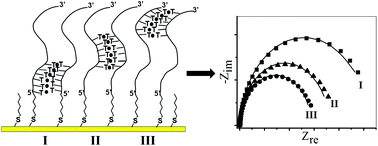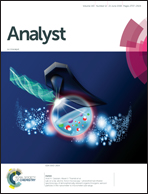Hg(ii) interactions with T-rich regions in oligonucleotides: effects of positional variations on the electrochemical properties†
Abstract
Hg(II) binding to thymine-rich oligonucleotides (ODNs) is investigated electrochemically. The focus of this study is to probe the effects of position on the electrochemical response. For this purpose, three oligonucleotides were investigated in which the position of a hexa-thymine repeat is varied within a surface-supported oligonucleotide. The hexa repeats were placed in the top, middle, and bottom positions within the strand with respect to the gold surface. The effects were monitored by electrochemical impedance spectroscopy and scanning electrochemical microscopy. Using charge transfer resistance (RCT) and tip current (I) as a measure, it was possible to monitor the effects of Hg(II) binding to the ds-oligonucleotide. The extent of film resistance reduces as the T-rich region moves from the bottom to top position within the film. The T-rich region closer to the gold surface probably builds less flexible and more rigid T–Hg(II)–T basepairs compared to the other two positions and is expected to stay in the upright orientation on the surface. This in turn results in significant differences in the electrochemical readout, demonstrating that the position of T-rich sequences within an oligonucleotide strand matters.



 Please wait while we load your content...
Please wait while we load your content...